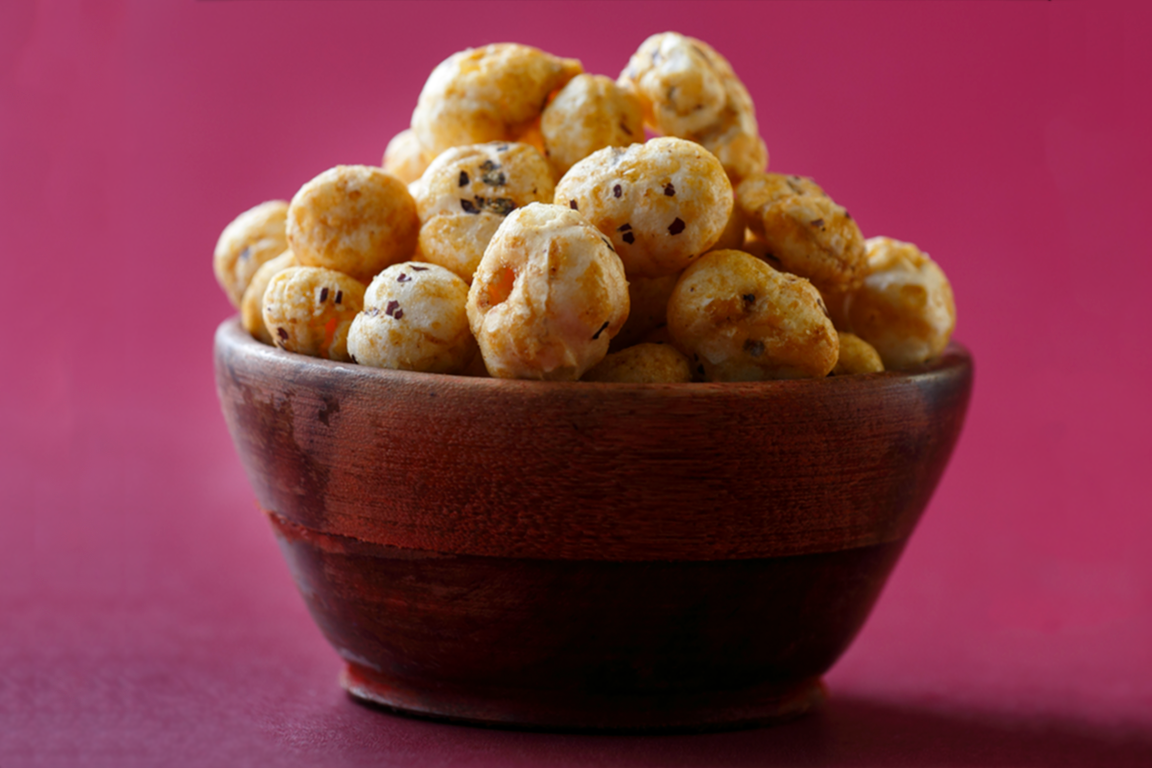
Edible Lotus Seeds Served 3 Ways
Whether puffed, dried or ground into a paste, makhana offers a blank canvas for both savory and sweet dishes.
Edible Lotus Seeds Served 3 Ways
Whether puffed, dried or ground into a paste, makhana offers a blank canvas for both savory and sweet dishes.
By Rob Corliss
December 18, 2023
By Rob Corliss
December 18, 2023
Edible lotus seeds are garnering culinary attention for their rich, gluten-free protein content, along with flavor neutrality and textural versatility. Harvested primarily in India and other areas of Asia from makhana, a flowering plant in the water lily family, the dried and puffed formats of the seeds yield a blank flavor canvas for both savory and sweet stylings.
For example, the dried seeds can be transformed into a silky-smooth sweet paste that boasts a caramelized flavor. Or soak them overnight, remove the green germ and then fry, roast, boil or bake them to produce a firm, chewy texture. The puffed format is reminiscent of crunchy, airy popcorn.
In various forms, lotus seeds are making moves on menus as chefs explore the possibilities. San Francisco’s Harborview Restaurant & Bar serves up Longevity Peach Buns filled with salted egg yolk and lotus seed paste, while Scotch Lodge, in Portland, Ore., uses lotus seeds in a Lotus Esprit cocktail, featuring Japanese whisky, lemon, Genmaicha, lotus seed orgeat and egg white.
Some other potential pairings that pull from a global palate include:
- Adobo
- Baharat
- Berbere
- Chaat masala
- Chamoy
- Cocoa powder
- Flavored sea salts
- Furikake
- Jerk
- Korean barbecue
- Maple-chile
- Tajín
- Togarashi
3 Ways with Makhana
1
Puffed Lotus Seeds – plain or flavored
- Use as elevated croutons for salads, soups and congee.
- Crush for a cooked meat or seafood topper.
- Add as an intriguing finishing textural element to fried rice, scrambled eggs, shakshuka, poke, ceviche, a burrito or a wrap.
- Combine with spiced nuts, pretzels and dried fruits in a bar snack mix.
2
Dried Lotus Seeds – fried, sautéed, roasted, boiled or baked
- Simmer in curries, stews, chili, mushroom ragout or with braised lentils.
- Add to vegetable stir-fries, grain bowls, salads and chutneys.
- Blend into chickpea hummus, nut butters, miso sauces, aïolis and vegetable spreads.
3
Lotus Seed Paste – sweetened
- Apply as a filling or flavoring for doughnuts, pastries, cinnamon rolls, brownies, mochi or mooncakes.
- Blend with caramel, chocolate, cream cheese, macerated berries or kaya.
One Chef’s Take on Makhana

Photo Credit: Mortar & Pestle Bar
“We introduced makhana (lotus seed/fox nut), which is regarded as a superfood. We roast ours and then generously dust it with housemade gujarati dust [a spice blend that features garlic, sesame seeds, desiccated coconut, chile powder and other proprietary spice]. We are going to be using makhana in our salads and street foods next.”
—Akash Kapoor, CEO, Mortar & Pestle Bar, San Francisco
Edible lotus seeds are garnering culinary attention for their rich, gluten-free protein content, along with flavor neutrality and textural versatility. Harvested primarily in India and other areas of Asia from makhana, a flowering plant in the water lily family, the dried and puffed formats of the seeds yield a blank flavor canvas for both savory and sweet stylings.
For example, the dried seeds can be transformed into a silky-smooth sweet paste that boasts a caramelized flavor. Or soak them overnight, remove the green germ and then fry, roast, boil or bake them to produce a firm, chewy texture. The puffed format is reminiscent of crunchy, airy popcorn.
In various forms, lotus seeds are making moves on menus as chefs explore the possibilities. San Francisco’s Harborview Restaurant & Bar serves up Longevity Peach Buns filled with salted egg yolk and lotus seed paste, while Scotch Lodge, in Portland, Ore., uses lotus seeds in a Lotus Esprit cocktail, featuring Japanese whisky, lemon, Genmaicha, lotus seed orgeat and egg white.
Some other potential pairings that pull from a global palate include:
- Adobo
- Baharat
- Berbere
- Chaat masala
- Chamoy
- Cocoa powder
- Flavored sea salts
- Furikake
- Jerk
- Korean barbecue
- Maple-chile
- Tajín
- Togarashi
3 Ways with Makhana
1
Puffed Lotus Seeds – plain or flavored
- Use as elevated croutons for salads, soups and congee.
- Crush for a cooked meat or seafood topper.
- Add as an intriguing finishing textural element to fried rice, scrambled eggs, shakshuka, poke, ceviche, a burrito or a wrap.
- Combine with spiced nuts, pretzels and dried fruits in a bar snack mix.
2
Dried Lotus Seeds – fried, sautéed, roasted, boiled or baked
- Simmer in curries, stews, chili, mushroom ragout or with braised lentils.
- Add to vegetable stir-fries, grain bowls, salads and chutneys.
- Blend into chickpea hummus, nut butters, miso sauces, aïolis and vegetable spreads.
3
Lotus Seed Paste – sweetened
- Apply as a filling or flavoring for doughnuts, pastries, cinnamon rolls, brownies, mochi or mooncakes.
- Blend with caramel, chocolate, cream cheese, macerated berries or kaya.
One Chef’s Take on Makhana

Photo Credit: Mortar & Pestle Bar
“We introduced makhana (lotus seed/fox nut), which is regarded as a superfood. We roast ours and then generously dust it with housemade gujarati dust [a spice blend that features garlic, sesame seeds, desiccated coconut, chile powder and other proprietary spice]. We are going to be using makhana in our salads and street foods next.”
—Akash Kapoor, CEO, Mortar & Pestle Bar, San Francisco
About the Author
![]() Rob Corliss is a three-time James Beard House guest chef with more than 30 years of experience that includes running world-class hotels, launching new concepts, working in top marketing agencies and owning the culinary consultancy ATE (All Things Epicurean) since 2009. Based in Nixa, Mo., ATE has an energizing passion focused on flavor innovation and is dedicated to connecting people to their food, environment and wellness. Rob is also a regular contributor to Flavor & The Menu.
Rob Corliss is a three-time James Beard House guest chef with more than 30 years of experience that includes running world-class hotels, launching new concepts, working in top marketing agencies and owning the culinary consultancy ATE (All Things Epicurean) since 2009. Based in Nixa, Mo., ATE has an energizing passion focused on flavor innovation and is dedicated to connecting people to their food, environment and wellness. Rob is also a regular contributor to Flavor & The Menu.








